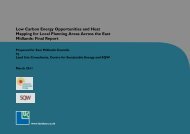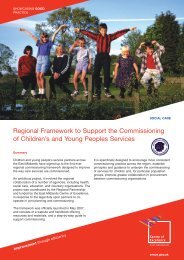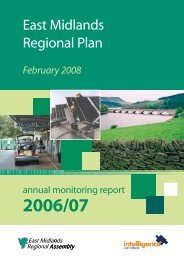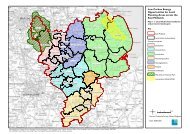East Midlands Regional Spatial Strategy 2005/06
East Midlands Regional Spatial Strategy 2005/06
East Midlands Regional Spatial Strategy 2005/06
You also want an ePaper? Increase the reach of your titles
YUMPU automatically turns print PDFs into web optimized ePapers that Google loves.
Policy 11: <strong>Spatial</strong> Priorities for Development<br />
outside the Peak District National Park<br />
There is a concentration on local needs for<br />
housing and employment, rather than<br />
encouraging in-migration and commuting to<br />
nearby conurbations.The high quality<br />
environment is to be respected<br />
Targets: • None<br />
Indicators:<br />
• Number of new affordable houses built (regional<br />
figure equates to approximately 25% of total stock)<br />
• Full time employment rates<br />
• Visitor spending<br />
• Number of new jobs created<br />
Results<br />
• See below<br />
Data Analysis and Policy Commentary<br />
8.48 Due to the need for a definition of the area to<br />
which this policy relates there is no data provided<br />
specifically for this policy. However, data and policy<br />
commentary presented for Policy 10 above on<br />
provision of and access to employment is relevant<br />
here.<br />
Policy 12: Managing Tourism and Visitors in<br />
the Peak Sub Area<br />
The aim of this policy is for management in<br />
accordance with sustainable development criteria<br />
and to ease pressures in the Peak District National<br />
Park<br />
Targets:<br />
• None<br />
Indicators:<br />
• Number of visitors and amount of spend per visitor<br />
• Number of new visitor attractions in areas<br />
immediately outside the National Park<br />
• Number of jobs in tourism related activities<br />
Results:<br />
8.49 See the results for policy 10 above that cover<br />
tourist visitor numbers and spend.<br />
Table 8.16 - Employment in Tourism Related Industries<br />
<strong>East</strong> <strong>Midlands</strong> <strong>Regional</strong> <strong>Spatial</strong> <strong>Strategy</strong> Annual Monitoring Report <strong>2005</strong>/<strong>06</strong><br />
Derbyshire Dales<br />
High Peak<br />
<strong>East</strong> <strong>Midlands</strong><br />
Data Analysis<br />
2001 2002 2003 2004* <strong>2005</strong> % change<br />
04-05<br />
4,155<br />
2,800<br />
126,995<br />
3,346<br />
2,150<br />
133,963<br />
4,570<br />
3,152<br />
132,987<br />
3,677<br />
2,388<br />
135,554<br />
3,864<br />
2,607<br />
141,858<br />
8.50 The ABI data shows that between 2004 and <strong>2005</strong> there was an increase in employment in tourism related<br />
industries in both Derbyshire Dales and High Peak and that these industries account for between, approximately,<br />
9.0% (High Peak) and 12.0% (Derbyshire Dales) of total jobs in the local economies.<br />
5.1<br />
9.2<br />
4.7<br />
% all jobs which<br />
are in tourism <strong>2005</strong><br />
Source: NOMIS<br />
* 2004 data has been revised by ONS and differs from that published in the previous monitoring report<br />
11.7<br />
8.9<br />
7.6<br />
152
















